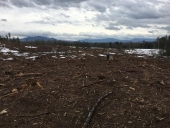




 1
1




 We've also left low windrows of slash across the contour, to stop runoff.
We've also left low windrows of slash across the contour, to stop runoff.
Idle dreamer
 1
1




 2
2












 1
1




 1
1




 1
1




The ultimate goal of farming is not the growing of crops, but the cultivation and perfection of human beings. - Masanobu Fukuoka
 1
1




 1
1




Never doubt that a small group of dedicated people can change the world, Indeed it is the only thing that ever has. Formerly pa_friendly_guy_here
 2
2




The ultimate goal of farming is not the growing of crops, but the cultivation and perfection of human beings. - Masanobu Fukuoka
 4
4




I am passionate about effective land clearing solutions and sustainable site preparation. Open to discussions on best practices and industry innovations




John P wrote:Hey everyone, one of my first real posts here, looking for some advice
My father and I have been hoping to clear some land to plant for multiple livestock forages for goats. We already cleared about 1.5-2 acres, but it is obvious we did not do it right. A trackloader and tractor compacted the soil and accelerated erosion over time. Clearly not a good practice as we found out the hard way, and now we are planting cover crops and grasses and letting that land be for it to come back to health. I have seen the birds and other creatures slowly moving back over the past two years and we are trying to intersect multiple different types of perennial covers.
We need to clear about 4-5 acres that has great carbon content in the humus and I would not want to let this great soil wash away. What is the best way to clear land using permaculture/sustainable methods? I was thinking and guessed it would be something like starting from the inside moving towards the outside of the section in question, clearing the land with chainsaws and leaving shade trees/diversity trees but enough taken away so there is sunlight for some crops. Then, I guessed that a stump grinder would be good to get rid of the stumps while leaving the roots to hold the soil. The section in question would ideally in the future be turned into fruit and nut trees similar to the food forests I have read about in permaculture books, but I am no expert. I would like to be able to grow fruit/nuts/and then plants on the ground such as oil bearing seeds to produce biodiesel...
What do you all think? What is the best way to clear land (which is semi hilly) without losing the valuable topsoil, compacting the soil, and hurting the environment any more than can be avoided? Thanks for your time and I appreciate any advice!
Passionate researcher and hands-on gardener
Visit my blog: for Sustainable Gardening Tips
 3
3




Be nice.
 2
2




 4
4




 2
2




I am passionate about effective land clearing solutions and sustainable site preparation. Open to discussions on best practices and industry innovations
 2
2




Invasive plants are Earth's way of insisting we notice her medicines. Stephen Herrod Buhner
Everyone learns what works by learning what doesn't work. Stephen Herrod Buhner

|
Please do not shoot the fish in this barrel. But you can shoot at this tiny ad:
The new kickstarter is now live!
https://www.kickstarter.com/projects/paulwheaton/garden-cards
|





